Trees Birds Mammals Fish Amphibians Reptiles
Wild Algarve
Bookshop
Lactarius camphoratus (Bull.) Fr. - Curry Milkcap
Phylum: Basidiomycota - Class: Agaricomycetes - Order: Russulales - Family: Russulaceae
Distribution - Taxonomic History - Etymology - Identification - Culinary Notes - Reference Sources
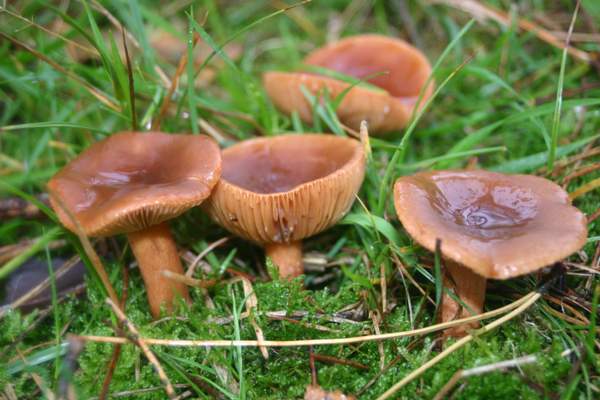
When dried, caps of the Curry Milkcap off a strong odour reminiscent of curry – the reason for common name for this pine-forest fungus, which is referred to in North America as the Candy Cap.
Distribution
In Britain and Ireland Lactarius camphoratus is
a widespread and fairly common species, occuring usually in
groups rather than solitarily.
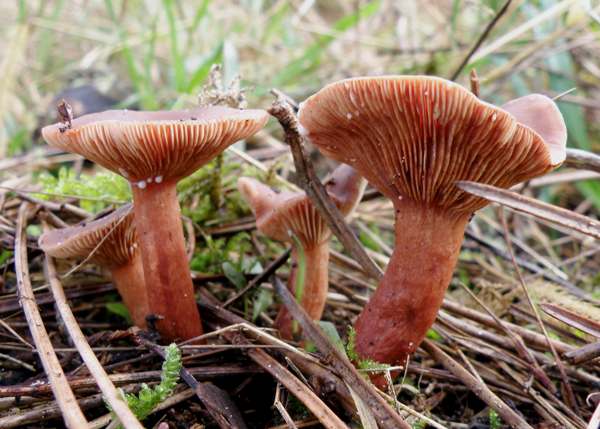
The Curry Milkcap occurs throughout much of mainland Europe and Asia; it is also recorded on the eastern side of North America.
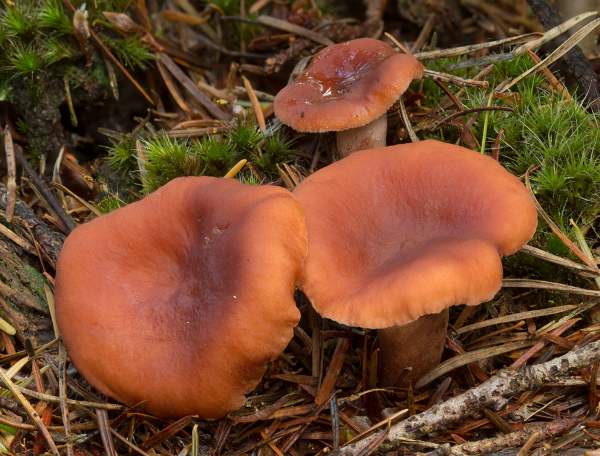
Taxonomic history
The Curry Milkcap was described in 1792 by the French mycologist Jean Baptiste Francois (Pierre) Bulliard, who gave it the binomial scientific name Agaricus camphoratus. (Vast numbers of gilled fungi were dumped into the Agaricus genus in the early days of fungal taxonomy; most have since been moved to other genera leaving in the present-day Agaricus genus a much smaller number of gilled mushrooms that are sometimes referred to as the 'true mushrooms'.) It was the Swedish mycologist Elias Magnus Fries who in 1838 transferred this milkcap to the genus Lactarius, making its scientific name Lactarius camphoratus, which is still the binomial name by which the Curry Milkcap is generally known today.
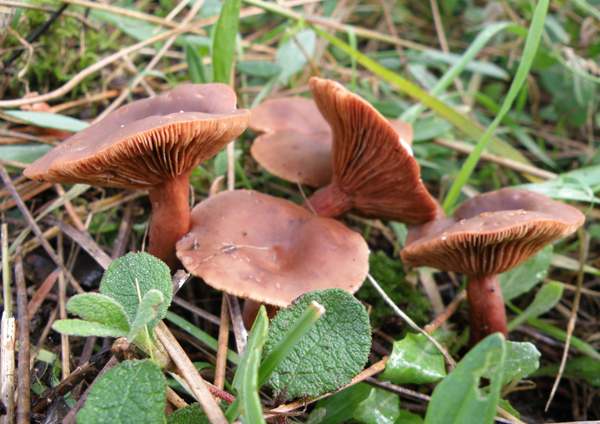
Synonyms of Lactarius camphoratus include Agaricus camphoratus Bull., Agaricus subdulcis ß camphoratus (Bull.) Fr., Lactarius cimicarius (Batsch) Gillet, Lactarius terreyi Berk. & Broome, and Lactarius camphoratus var. terreyi (Berk. & Broome) Cooke.
Etymology
The generic name Lactarius means producing milk (lactating) - a reference to the milky latex that is exuded from the gills of milkcap fungi when they are cut or torn. The specific epithet camphoratus is a reference to the distinctive smell of this milkcap mushroom, which at the time its basionym was selected was considered to be like camphor - originally made from the sap of camphor trees and in the past used not only as a moth repellent but also in the manufacture of fireworks. (Nowadays most people in Western Europe are probably much more familiar with the smell of curry than of mothballs!)
Identification Guide
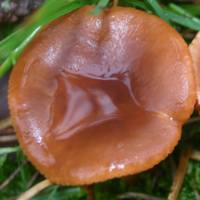 |
Cap
Red-brown, darker towards centre; convex, developing a central depression usually with a slight umbo; surface smooth and matt; margin slightly furrowed; 3 to 6cm across. |
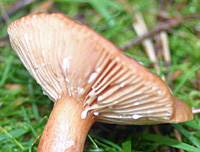 |
Gills
Pinkish cream to ochre, turning red-brown with age; slightly decurrent; crowded; releasing abundant mild-tasting latex.
Stem
Colour as cap margin, darker towards base; cylindrical; 3 to 10cm long, 4 to 8mm diameter. |
| |
Spores
Subglobose to broadly ellipsoidal, 7.5-8 x 6.5-7.5μm, hyaline; ornamented with mainly isolated warts 0.5 to 1 μm tall and a few connecting ridges not forming a coherent reticulum.
Spore print
Cream. |
Odour/taste |
No distinctive odour when fresh, but these mushrooms release a strong odour very reminiscent of curry (or some say freshly-mown grass) when being dried. (The odour of drying fruitbodies has also been described as similar to maple syrup.) The taste of this milkcap is mild. |
Habitat & Ecological role |
Mainly in pine forests, but very occasionally this little milkcap is also found in broadleaf woodland under birches. |
Season |
August to November in Britain and Ireland. |
Similar species |
Lactarius subdulcis is a smaller milkcap sometimes of
similar coloration; it occurs under beech trees. |
Culinary Notes
Lactarius
camphoratus is an edible mushroom when cooked thoroughly. In Germany and some European countries dried Curry Milkcaps are crushed and used as a condiment to flavour soups and sauces. |
Reference Sources
Pat O'Reilly (2016). Fascinated by Fungi, First Nature Publishing
Jacob Heilmann-Clausen, Annemieke Verbeken, & Jan Vesterholt (1998). The Genus Lactarius (Fungi of Northern Europe—Vol. 2) The Danish Mycological Society.
Funga Nordica, Henning Knudsen and Jan Vesterholt, 2008.
Fungi of Switzerland, volume 6: Russulaceae, Kränzlin, F.
BMS List of English Names for Fungi.
Paul M. Kirk, Paul F. Cannon, David W. Minter and J. A. Stalpers. (2008). Dictionary of the Fungi; CABI.
Taxonomic history and synonym information on these pages is drawn from many sources but in particular from the British Mycological Society's GB Checklist of Fungi.
Acknowledgements
This page includes pictures kindly contributed by David Kelly.
Top of page...
Fascinated by Fungi. Back by popular demand, Pat O'Reilly's best-selling 450-page hardback book is available now. The latest second edition was republished with a sparkling new cover design in September 2022 by Coch-y-Bonddu Books. Full details and copies are available from the publisher's online bookshop...